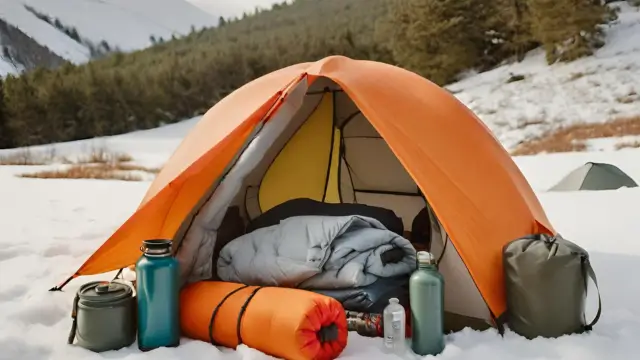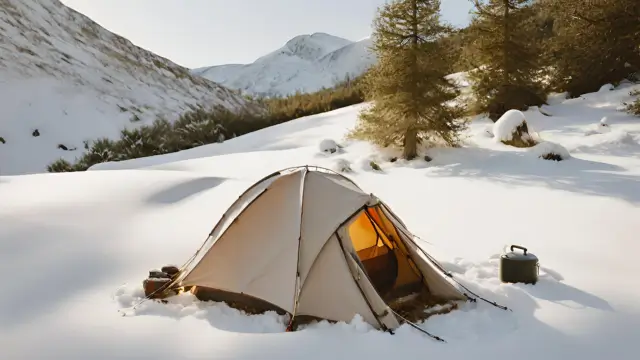How to Go Winter Camping: A Complete Guide for Beginners
Winter camping can be a challenging but rewarding experience, even for beginners.
as a seasoned camper and passionate about helping people get outdoors and enjoy the world of camping.
In this article, I’ll share my tips and my personal experiences to help people who are interested in learning about how to go winter camping safely and comfortably, even if they have no prior experience.
Choosing the Right Gear for Safe Winter Camping

One of the most important aspects of winter camping is choosing the right gear. You need to make sure that your gear is suitable for the weather and the terrain you will encounter.
Here are some of the essential items you need for winter camping:
A four-season tent
This is a tent that can withstand strong winds, heavy snow, and low temperatures.
A four-season tent usually has a sturdy frame, a durable fabric, and a full-coverage fly. It also has vents that allow air circulation and prevent condensation.
A sleeping bag
You need a sleeping bag that is rated for the lowest temperature you expect to face. A good rule of thumb is to choose a sleeping bag that is 10 degrees warmer than the coldest temperature you will encounter.
For example, if the temperature drops to -10°C at night, you need a sleeping bag that is rated for -20°C. You can also use a sleeping bag liner or a bivy sack to add extra warmth and protection.
A sleeping pad
This is a pad that provides insulation and cushioning between you and the ground.
A sleeping pad can make a big difference in your comfort and warmth. You can choose between an air pad, a foam pad, or a self-inflating pad.
- Air pads are lightweight and compact, but they can be punctured or deflated by cold air.
- Foam pads are durable and cheap, but they are bulky and heavy.
- Self-inflating pads are a good compromise between the two, but they can be expensive and noisy.
Recommended Reading: How To Increase The R-Value Of Your Sleeping Pad
A stove and fuel
Get a stove that can work in cold weather and at high altitudes. You also need enough fuel to cook your meals and melt snow for drinking water.
You can choose between a liquid fuel stove or a canister stove. Liquid fuel stoves are more reliable and efficient in cold weather, but they are heavier and require more maintenance.
Canister stoves are lighter and easier to use, but they can lose pressure and performance in cold weather.
Recommended Reading: Can You Use A Camping Stove In A Tent?
A water bottle or a hydration system
You need to stay hydrated in winter camping, as dehydration can lead to hypothermia and frostbite. You can use a water bottle or a hydration system to carry your water.
- A water bottle is simpler and cheaper, but it can freeze if not insulated or kept close to your body.
- A hydration system is more convenient and allows you to drink without stopping, but it can also freeze if not insulated or blown out after each sip.
Read more: How To Keep Water From Freezing During Winter Camping?
Winter clothing
You need clothing that can keep you warm, dry, and comfortable in winter conditions.
You should follow the layering principle, which means wearing multiple layers of clothing that you can adjust according to your activity level and the weather. The three main layers are:
- The base layer: This is the layer that touches your skin and wicks away sweat and moisture. You should choose synthetic or wool fabrics that are breathable and quick-drying. Avoid cotton, as it absorbs moisture and loses its insulating properties when wet.
- The mid layer: This is the layer that provides insulation and traps heat. You should choose fleece or down fabrics that are lightweight and compressible. Avoid bulky or heavy fabrics that restrict your movement or take up too much space in your backpack.
- The outer layer: This is the layer that protects you from wind, rain, snow, and abrasion. You should choose waterproof or water-resistant fabrics that are durable and breathable. Avoid fabrics that are too tight or too loose, as they can compromise your insulation or ventilation.
Check out our article to learn how to dress for winter camping.
Packing for Winter Camping
Packing for winter camping can be tricky, as you need to balance between weight and comfort.
You want to pack enough gear to keep you warm and safe, but not too much gear that will slow you down or tire you out.
Here are some tips for packing for winter camping:
- Make a packing list: This will help you organize your gear and avoid forgetting anything important.
- Pack smartly: Use compression sacks or stuff sacks to reduce the volume of your gear. Use ziplock bags or dry bags to keep your gear dry and organized. Use a backpack that fits your body and has enough capacity and compartments for your gear.
- Pack strategically: Distribute the weight of your gear evenly and place the heaviest items close to your back and center of gravity. Place the items you need frequently or urgently in the outer pockets or on top of your backpack. Place the items you don’t need until you reach your campsite at the bottom of your backpack.
- Pack lightly: Eliminate any unnecessary or redundant items from your packing list. For example, you don’t need more than one set of clothes, as you can wash and dry them at night. You don’t need more than one pot or pan, as you can cook and eat from the same container. You don’t need more than one book or gadget, as you can enjoy the nature and the company of your fellow campers.
Essential Tips for Setting Up Camp in Winter Conditions

Setting up camp in winter conditions can be challenging, as you need to find a suitable spot, clear the snow, pitch your tent, and secure your gear.
Here are some steps for setting up camp in winter conditions:
1. Find a suitable spot:
Look for a flat, sheltered, and dry spot that is away from avalanche zones, wind tunnels, water sources, or falling branches
Avoid spots that are too exposed to the sun, as they can melt during the day and freeze at night.
2. Clear the snow:
Use a shovel or your boots to clear the snow from your chosen spot.
You want to create a smooth and compact surface that is slightly larger than your tent footprint.
You can also use the snow to build a wall or a trench around your spot for extra protection from the wind and the cold.
3. Pitch your tent:
Follow the instructions of your tent manufacturer and use the appropriate stakes or anchors for the snow.
You can also use rocks, branches, or snowshoes to secure your tent.
Make sure your tent is well-ventilated and free of snow or ice on the inside and outside.
Read also: How To Secure A Tent Without Stakes
4. Secure your gear:
Store your gear inside your tent or under a flysheet to keep it dry and safe.
Keep your water bottle and fuel bottle inside your sleeping bag or close to your body to prevent them from freezing.
Keep your food in a sealed container or a bear canister to prevent it from attracting animals.
Staying Warm and Safe in Cold Weather
Staying warm and safe in cold weather is crucial for winter camping, as you can face risks such as hypothermia, frostbite, dehydration, carbon monoxide poisoning, or fire hazards.
Here are some tips for staying warm and safe in cold weather:
- Stay hydrated. Drink plenty of water throughout the day and avoid alcohol or caffeine, as they can dehydrate you or impair your judgment. Melt snow for drinking water if you run out of water or if the water sources are frozen. Read more about How Much Water To Bring Camping.
- Stay nourished. Eat high-calorie and high-protein foods that can provide you with energy and heat. Snack frequently and avoid skipping meals, as you burn more calories in cold weather.
- Stay active. Move around and exercise regularly to keep your blood circulation and body temperature up. Avoid sweating too much, as it can lower your body temperature when it evaporates.
- Stay dry. Change into dry clothes if you get wet from sweat, rain, snow, or condensation. Dry your clothes by hanging them inside your tent or near a fire.
- Stay warm. Use a sleeping bag, a sleeping pad, a bivy sack, a hot water bottle, or a chemical warmer to keep yourself warm at night. Wear layers of clothing that you can adjust according to your activity level and the weather.
- Stay safe. Check the weather forecast and avalanche conditions before you go winter camping and during your trip. Carry a first aid kit, a survival kit, a whistle, a flashlight, a fire starter, a knife, and a map and compass or a GPS device with you at all times. Know how to recognize and treat hypothermia, frostbite, dehydration, carbon monoxide poisoning, or fire hazards.
Conclusion
Camping in the cold weather is an amazing way to experience nature in a different and challenging way. It can be a fun and rewarding experience if you plan ahead and prepare well.
By following this guide, you will be able to choose the right gear, pack, set up camp, and stay warm and safe in cold weather.
I hope this article has helped you learn how to go winter camping and inspired you to try it out for yourself. Camping in chilly conditions is one of my favorite activities, and I’m sure you will love it too! Happy camping!
Need More Winter Camping Tips?
11 Tips For Camping In Windy Conditions
Camping In The Rain: 5 Essential Tips